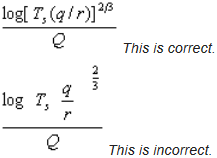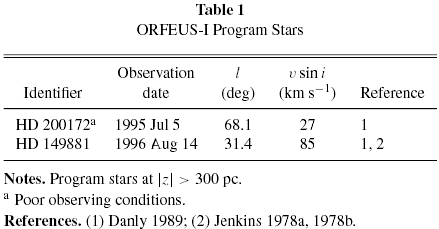Authors are strongly encouraged to prepare their manuscripts using the most recent version of the AASTeX macro package, and to submit them electronically. Detailed guidelines on the preparation of manuscripts using AASTeX is available. The journals also accept manuscripts prepared using Microsoft Word (native Word .doc/x format). A MS/Word template is also available. In addition, Word documents should use Courier font and 10 point size with 1.5 line spacing. Authors should not use images for tables or equations.
Graphics are accepted in vector Encapsulated PostScript (EPS) and Portable Document Format (PDF) as well as scalar formats (JPG, PNG, TIFF) with sufficient resolution. We also accept web-only content, including animations, extended figure sets, and interactive JavaScript driven graphics for inclusion into the final versions of your published articles. Further information on figures and detailed graphics guidelines are available.
Articles must be written in English. Authors whose grasp of written English is not secure should obtain help from colleagues proficient in English. While a polished literary style is not demanded of scientific articles, they should conform to the elementary rules of grammar, syntax, punctuation, and clarity. Slang and jargon should be avoided.
Observance of the following guidelines will prevent some common errors:
- All tables and figures must be mentioned explicitly by number and appear in correct numerical order in the body of the text. That is, Tables 1, 2, 3, and 4 must each be mentioned in the text at least once, and the first mention of Table 3 should not precede the first mention of Table 2.
- The reference list and text citations should agree and be accurate. All text citations must appear in the reference list, and all entries listed in the reference list must be cited in the text.
- Acronyms and abbreviations should be spelled out the first time they are used unless they are common throughout the discipline. Terms defined in the abstract should be defined independently in the main text.
- Symbols for chemical elements are in normal type, not italics. The mass number precedes the symbol (e.g., 12C). Roman numeral designations for spectra of ions are given in small capitals and preceded by a space (e.g., H II).
- Standard three-letter abbreviations are preferred for constellation names (e.g., Cep, UMa); for a full list, see the IAU website. Object names and acronyms are spelled out in full in titles.
- Use standard abbreviations for SI (e.g., m, km, mm) and natural units (e.g., au, pc, cm). If English units such as inches or pounds per square inch are used, metric equivalents should follow in parentheses.
- Expressions of rate, such as kilometers per second, ergs per meter, etc., are set as, for example, km s-1, erg m-1, not km/s, erg/m. In tables, units should be specified in column or row heads, or explained in a footnote to the table, not given with each individual value in the table body.
- Right ascension and declination in text and equations are given in the form: 3h25m8s.15, 90°26’14 5″.
- Dates are written in the order: year, month, and day (e.g., 1996 January 1). In tables, use three-letter abbreviations for months, without a period. Universal time designations are written 22:37:48 UT (for hours, minutes, seconds).
- Avoid beginning sentences with a symbol, number, or lower-case letter.
- The word “data” is plural and takes a plural verb.
- Closing quotation marks follow periods and commas but precede colons and semicolons.
- In a series of three or more items, include a comma before the final item (e.g., “space, time, and matter”).
- The AAS Journals follow American usage of “that” to introduce restrictive clauses, “which” for non-restrictive clauses, and observe generally conservative grammar conventions throughout.
Including line numbers in your manuscript provides an easy way for reviewers to reference specific locations in the text thus we now require authors to include them in both submission and revision. Authors that use AASTeX v6+ can invoke the linenumbers style option to easily provide this functionality.
\documentclass[linenumbers]{aastex631}
Authors that use other versions of LaTeX have to include the lineno.sty package which can be obtained at CTAN. Documentation for lineno.sty is available. Once the package is install, add the following to the header of your LaTeX manuscript.
\usepackage{lineno}
\linenumbers
MS/Word users can also turn on this functionality. While in the Word document click Layout and then select Line Numbers. Use the Continuous option. Additional details, including how to use line numbers in earlier versions, is available on the Microsoft support page.
The Planetary Science Journal uses Double Anonymous Review (DAR) as the default for all papers. The other journals of the AAS offer this as an option. An explanation for this policy, and suggestions for its implementation were assembled by the DPS Professional Culture and Climate Subcommittee and can be found here. At a minimum, this means that the author list, the institution list, and the acknowledgements section will be removed by the Editorial Office to create a ‘review copy’, which will be sent to reviewers. However, the process works best if the authors consider this explicitly while composing their manuscript.
Authors may unintentionally reveal their identity in the style of their writing. The following recommendations should minimize this problem. They may improve a manuscript even if the authors’ identity is not an issue.
- Do not include author names or affiliations in any sections beyond the main author list, the institution list, and the acknowledgements. This includes (but is not limited to) page headers, footers, diagrams, figures, or digital watermarks.
- When citing references within the manuscript, use third person neutral wording. This especially applies to self-referencing. For example, replace phrases like “as we have shown in our previous work (Sagan et al. 1993)” with “as Sagan et al. (1993) showed…”. Do not refer to previous observational campaigns, spacecraft missions, expeditions, etc. in an identifying fashion. For instance, rather than write “we studied another KBO, similar to the one we encountered with New Horizons,” instead write “New Horizons previously encountered (286958) Arrokoth (Stern et al. 2019) which is similar to the KBO described in this work …”
It can take some effort for authors to alter their writing style, but doing so will help the reviewers focus on the scientific value of the work as it is presented, and not on the authors.
It should be apparent that even under the default DAR policy of the PSJ, an author can still intentionally identify themselves by presenting the same work at meetings, through a preprint posting, or by other methods outside the PSJ peer-review process, and that is fine.
If authors wish to opt-out of DAR for the PSJ peer-review process, they can do so at submission time by writing in the ‘Manuscript Comment’ box a note to the Editors indicating that they wish to opt-out of DAR. This is similar to the way a reviewer can reveal their identity to the authors while writing a review for one of the AAS journals. However, it is never appropriate for an author to seek confirmation of a referee’s identity nor for a reviewer participating in a dual anonymous review to go out of their way to identify the authors.
If your article lists objects that are newly discovered, the IAU Commission 5, through its Task Group on Designations, requests that such objects be designated according to the IAU Recommendations for Nomenclature. The proper procedure is to design a name according to IAU rules and then to register it with the Commission before the article is published. Please be sure that any object that might have been named in the past is not now given a new, redundant, name.
For all other objects listed in your text, please follow the “Best Practices for Data Publication” (Chen et al. 2022, ApJS, doi:10.3847/1538-4365/ac6268), Section 2.1 on Nomenclature. To summarize it is important that you use established names, ensure that these established names are correctly formatted, and do not use truncated names as the sole identifier in your text. The most recent version of these Best Practices guidelines can be found at NED (doi:10.26132/NED7).






